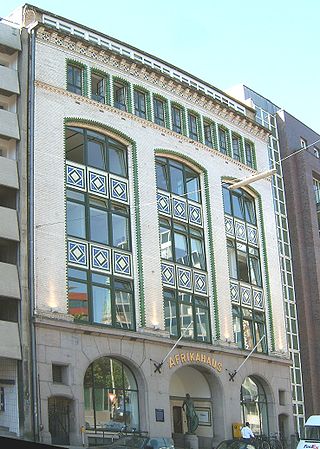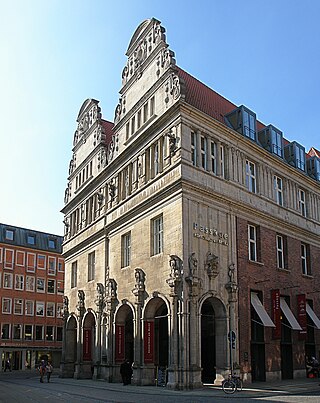Gallery
- Miramar-House
- Main entrance
- Mine worker
- Architect
- Merchant
- Sailor
- Farmer
- Steel worker
The Miramar House is a historic Kontorhaus in Hamburg, built in the style of Brick Expressionism of the 1920s. It is located in the Hamburg-Altstadt district. The house has been a listed building since 1999. It is part of the UNESCO World Heritage Site Kontorhaus District. [1]
The ground plan of the building adapts to the Schopenstehl and Kattrepel streets, which run at a slightly acute angle. The rounding off of the building towards the street corner was unusual for the time and became stylistically influential for many of the following buildings. The four upper floors were built in clinker brickwork. The two plinth floors are plastered. The house is divided horizontally by several cornices. The figures are by Richard Kuöhl. They represent typical professions on which the Hamburg economy is based. [2]

Te Motu Kairangi / Miramar Peninsula is a large peninsula on the southeastern side of the city of Wellington, New Zealand. It is located at the entrance to Wellington Harbour, in Wellington's eastern suburbs. According to Māori legend, it was formed when the taniwha Whaitaitai beached as he tried to escape the confines of the harbour. It contains the suburb of Miramar.


Salts Mill is a former textile mill, now an art gallery, shopping centre, and restaurant complex in Saltaire, Bradford, West Yorkshire, England. It was built by Sir Titus Salt in 1853, and the present-day 1853 Gallery takes its name from the date of the building which houses it. The mill has many paintings by the local artist David Hockney on display and also provides offices for Pace plc.

Murrays' Mills is a complex of former cotton mills on land between Jersey Street and the Rochdale Canal in the district of Ancoats, Manchester, England. The mills were built for brothers Adam and George Murray.

The Internationales Maritimes Museum Hamburg is a private museum in the HafenCity quarter of Hamburg, Germany. The museum houses Peter Tamm's collection of model ships, construction plans, uniforms, and maritime art, amounting to over 40,000 items and more than one million photographs. It opened in a former warehouse in 2008.

Bridgewater House, Manchester is a packing and shipping warehouse at 58–60 Whitworth Street, Manchester, England. It is recorded in the National Heritage List for England as a designated Grade II listed building.

Chester Rows are a set of structures in each of the four main streets of Chester, in the United Kingdom, consisting of a series of covered walkways on the first floor behind which are entrances to shops and other premises. At street level is another set of shops and other premises, many of which are entered by going down a few steps.

The Speicherstadt in Hamburg, Germany, is the largest warehouse district in the world where the buildings stand on timber-pile foundations, oak logs, in this particular case. It is located in the port of Hamburg—within the HafenCity quarter—and was built from 1883 to 1927.

The Afrikahaus is an office building at Große Reichenstraße 27 in the German city of Hamburg. It was built in 1899 as the headquarters of the C. Woermann firm by the Hamburg architect Martin Haller and was given listed monument status in 1972.

Asia House at No. 82 Princess Street, Manchester, England, is an early 20th century packing and shipping warehouse built between 1906 and 1909 in an Edwardian Baroque style. It is a Grade II* listed building as at 3 October 1974. Nikolaus Pevsner's The Buildings of England describes the warehouse, and its companion, No. 86, Manchester House, as "quite splendid ... good examples of the warehouse type designed for multiple occupation by shipping merchants". It attributes its design to I.R.E. Birkett, architect of the Grade II listed companion building, Manchester House, which is similar in design. English Heritage attributes it to Harry S. Fairhurst. Asia House has an "exceptionally rich" entrance hall and stairwell, "lined with veined marble and green and cream faience, with designs of trees and Art Nouveau stained glass".

The Kontorhaus am Markt in Bremen is a historical building in the city centre of Bremen. Today, it is used as a shopping mall. It is situated at the Bremer Marktplatz between three streets: Langenstrasse 2/8, Stintbruecke 1 and Bredenstrasse 13.

The Langenstraße is a historical street in the old town of Bremen in the north of Germany. First mentioned in 1234, it is one of Bremen's oldest streets and one of the most important for the city's merchants. It no doubt originated at the time when the first settlements grew up on the north bank of the Balge. It runs west from the Marktplatz parallel to the River Weser over Bürgermeister-Smidt-Straße to Geeren. Many of the street's historic buildings were seriously damaged during aerial bombings in the Second World War but were carefully reconstructed in the postwar period.

The Suding & Soeken building is a gabled house at No. 28 Langenstraße in Bremen, Germany. Referred to as a Kaufmannshaus or Kontorhaus, it is one of the city's few historic merchant houses to survive the war undamaged. It is noted for its projecting Renaissance bay window and its two-tiered Baroque stairway ascending from the hallway.

The Rand Water Board was established in 1903, tasked with supplying the water needed to support mining activities and sanitary living conditions for those living in the developing urban area of Johannesburg.
Eagley Mills is a complex of former cotton mills in Eagley, Bolton, England. The complex is adjacent to a model village originally built for the millworkers. The surviving mill buildings have since been converted to residential use.

Kopernika street is located in central Bydgoszcz. Several buildings on Kopernika Street are registered on the Kuyavian-Pomeranian Voivodeship Heritage List. The street is named for Nicolaus Copernicus.

The Kontorhaus District is the southeastern part of Altstadt, Hamburg, between Steinstraße, Meßberg, Klosterwall and Brandstwiete. The streetscape is characterised by large office buildings in the style of Brick Expressionism of the early 20th century.

The Sprinkenhof is a nine-storey office building built between 1927 and 1943 in Hamburg's Kontorhaus District. The complex borders the streets Altstädter Straße, Burchardstraße and Johanniswall, and the Springeltwiete runs through the inner courtyard. The Chilehaus is located directly to the northeast, separated only by the main road. As part of Kontorhaus District, the Sprinkenhof was inscribed as a UNESCO World Heritage Site in 2015.

The Speicherstadtrathaus is the administration building of Hamburger Hafen und Logistik AG. It is located in the historic warehouse complex of the Speicherstadt in the Port of Hamburg, Hamburg, Germany. The Speicherstadtrathaus has been a listed building since 1991 and has been on the UNESCO World Heritage List since July 5, 2015, along with the neighboring Kontorhaus District.